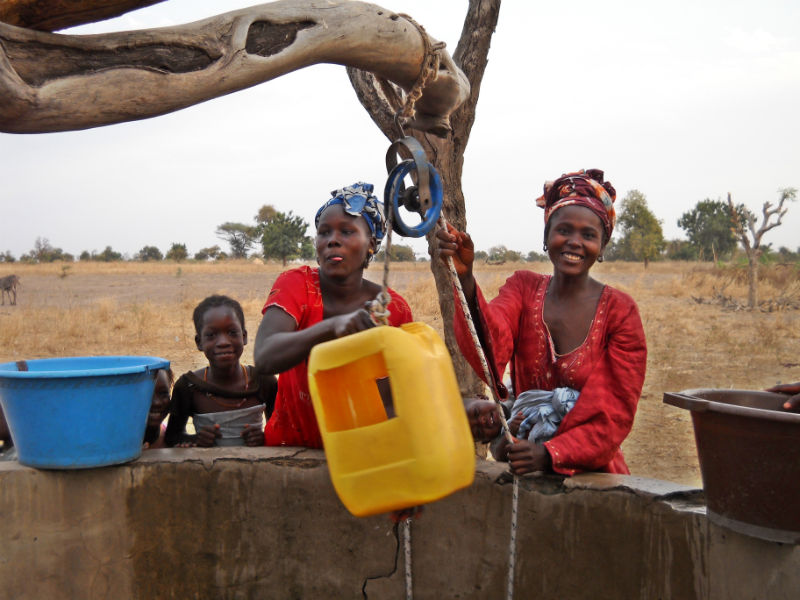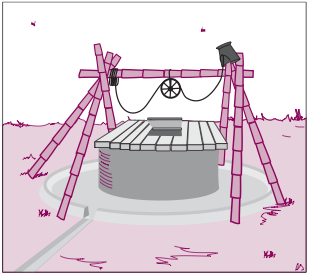Difference between revisions of "Rope and bucket"
| Line 1: | Line 1: | ||
| − | [[Image: | + | [[Image:RopeandBucketphoto.jpg|thumb|right|300px|Rope and bucket system. Fass Toucouleur, Kaolack Region, Senegal. Photo: [http://appropriateprojects.com/node/731 Fass Toucouleur Well Improvement Project.]]] |
This device is mainly used with hand-dug wells. A bucket on a rope is lowered into the water. When the bucket hits the water it dips and fills, and is pulled up with the rope. The rope may be held by hand, run through a pulley, or wound on a windlass. Sometimes, animal traction is used in combination with a pulley. Improved systems use a rope through a pulley, and two buckets – one on each end of the rope. For water less than 10 m deep, a windlass with a hose running from the bottom of the bucket to a spout at the side of the well can be used. However, the hygiene of this system is poorer, even if the well is protected. | This device is mainly used with hand-dug wells. A bucket on a rope is lowered into the water. When the bucket hits the water it dips and fills, and is pulled up with the rope. The rope may be held by hand, run through a pulley, or wound on a windlass. Sometimes, animal traction is used in combination with a pulley. Improved systems use a rope through a pulley, and two buckets – one on each end of the rope. For water less than 10 m deep, a windlass with a hose running from the bottom of the bucket to a spout at the side of the well can be used. However, the hygiene of this system is poorer, even if the well is protected. | ||
Revision as of 01:54, 2 May 2012

This device is mainly used with hand-dug wells. A bucket on a rope is lowered into the water. When the bucket hits the water it dips and fills, and is pulled up with the rope. The rope may be held by hand, run through a pulley, or wound on a windlass. Sometimes, animal traction is used in combination with a pulley. Improved systems use a rope through a pulley, and two buckets – one on each end of the rope. For water less than 10 m deep, a windlass with a hose running from the bottom of the bucket to a spout at the side of the well can be used. However, the hygiene of this system is poorer, even if the well is protected.
Contents
Suitable conditions
Construction, operations and maintenance
Range of depth: 0–15 m (or more sometimes).
Yield: 0.25 litres/s at 10 m.
The bucket is lowered and raised by playing out and pulling in the rope, or by rotating the windlass. Care must be taken to prevent the rope or bucket from be- coming soiled. Preventive maintenance consists of greasing the bearings of the windlass or pulley. Small repairs are limited to patching holes in the bucket and hose, reconnecting the hinge of the bucket, and fixing the windlass bearings or handle. All small repairs can be done by local people, and with tools and materials available in the community or area. Major repairs and replacements mainly consist of replacing the bucket, hose, rope, or part or all of the windlass. Woven nylon ropes may last for two years, but twined nylon or sisal ropes last only a few months. A good-quality hose may last for over two years, and most buckets last a year (depending on the material and quality). When people use their own rope and bucket, no extra organization is required. For community wells, a community committee usually organizes the maintenance and cleaning of the well, maintenance of the windlass, etc. Most repairs can be paid with ad hoc fund-raising.
Potential problems
— Poor-quality rope deteriorates quickly (e.g. sisal rope lasts for only a few months);
— The bucket falls into the well ... to prevent this, communities can keep a spare bucket and fit the bucket into a protective cage;
— The hose breaks frequently in windlass-and-hose systems;
— Poor hygiene, especially when the rope or bucket touches users’ hands or the ground;
— Communal wells tend to become more contaminated than family-owned wells, and the latter should be promoted whenever possible;
— The rope-and-bucket system is only suitable for limited depths.
Costs
From US$ 6 for a plastic bucket and 5 m of rope, to US$ 150 with a windlass, hose and closed superstructure, in Liberia (Milkov, 1987).
Field experiences
Area of use: All over the world.
Reference manuals, videos, and links
Acknowledgements
- Brikke, François, and Bredero, Maarten. Linking technology choice with operation and maintenance in the context of community water supply and sanitation: A reference document for planners and project staff. World Health Organization and IRC Water and Sanitation Centre. Geneva, Switzerland 2003.


